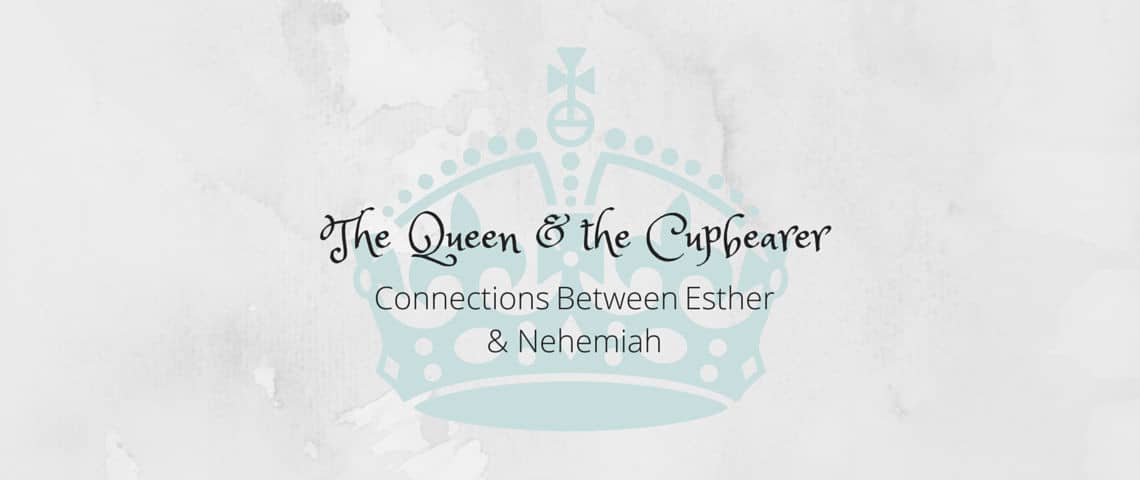The Old Testament book of Nehemiah takes place during a time of exile and captivity for the Jewish people.
In this fascinating account, Nehemiah, the Jewish cupbearer to the Persian King Artaxerxes [1], successfully petitions to take a group back to Jerusalem to rebuild the city walls after hearing they are in disrepair.
Recently I noticed a few interesting connections between Nehemiah and the story of Esther.
In Nehemiah 1 we read that the setting is the “citadel of Susa”. This is the same city in which the young Esther was forced to participate in a “beauty pageant” at the whim of a king named Xerxes (Esther 1). As you may remember, Esther becomes the next Queen of Persia and eventually risks her life to save the Jewish exiles living in Persia from extermination [2].
1. Esther and Nehemiah as Contemporaries
I’ve heard many sermons on Nehemiah in my lifetime, but don’t recall anyone ever mentioning this connection between Esther and Nehemiah. This may have to do with the fact that the books of Nehemiah and Esther are not placed in chronological order in the bible. The Book of Esther is placed after the Book of Nehemiah, but her story actually came first [3]. This opens the possibility that Esther and Nehemiah could have lived as contemporaries in the same city for a period of time. Here’s where it really gets interesting!
2. The Relationship between Artaxerxes 1 and Esther
King Artaxerxes not only allowed Nehemiah to return to Jerusalem, he even agreed to a request for supplies (Nehemiah 2:8). From what we know of Artaxerxes heritage, this is hard to understand. What made him sympathetic to the plight of the Jewish homeland, even to the point of providing resources? Was it his personal relationship with Nehemiah that accounted for his behavior, or was there something more?
There may have been some political reason for his sympathy, but there are also some personal factors to consider. Most scholars believe that Artaxerxes was the son of Esther’s husband, Xerxes. (Some have suggested that he was the son of Esther and Xerxes, but it is more probable that he was born to one of Xerxes’ other wives). Regardless, this means that depending on how long she lived, Esther and Artaxerxes may have lived on the palace grounds at the same time. While we can’t be sure a personal relationship existed, we can safely assume that Artaxerxes would have been very familiar with the story of Esther.
3. Esther’s Mission Extended – Beyond Saving the Jews?
I had trouble finding much historical evidence about the connection between Artaxerxes 1 and Esther in my brief search. But I did find this interesting article written for the Huffington Post by Yaacov Cohen:
“After the immediate danger to her community passed, Queen Esther stayed with Ahasuerus (Xerxes). Why did she stay with him, rather than restart her life? We need to put the Book of Esther into an historical context to better understand Esther’s choice. The story of Esther happened after Cyrus, the first Persian King, called for all deported Jews to return to Jerusalem to build the House of God (538 B.C., Ezra 1:2). Most of the Jews preferred the comfortable life of the Persian Empire to an arduous life rebuilding their devastated homeland. The Talmud sees Haman’s decree as a punishment from Heaven to these Jews. When, several years later, Nehemiah asked the Persian King for permission to return to Zion and rebuild Jerusalem, “the Queen is sitting by him” (Nehemiah 2:6), and she influenced the King’s decision to approve Nehemiah’s request. The Queen described in the Book of Nehemiah is Queen Esther. She stayed with Ahasuerus and sacrificed her personal happiness to complete her ultimate mission to enable the building of the Second Temple and the return to Zion”.
The Significance of the Connection for Women
Whether or not Cohen is right about the queen mentioned being Esther, I don’t think it’s a stretch to say that Artaxerxes’ sympathy for the Jews probably had a lot to do with her witness, influence and integrity. This would be consistent with a pattern seen often in the Old Testament, in which God intentionally chooses a woman to play an instrumental role in accomplishing his purposes (take Miriam, Deborah, Jael, and Huldah, for example).
Despite the prevalence of the patriarchal societies that developed after the Fall and the disruption of gender relationships recorded in Genesis 3, this pattern occurs often enough to suggest that these stories are more than incidental – I believe God was clearly making a point!
When studied alone, the book of Nehemiah can come off as a very “male-centric” story. It is mostly men who build the wall, and when the “roll” of Israel is recorded only men’s names are recorded. But if we look at the story in historical perspective and consider all of the players involved, it is not hard to make a case that there was more to Esther’s mission than the initial saving of the Jewish people from extinction recorded in the Book of Esther. Esther’s “long obedience in the same direction” (to quote Eugene Peterson) laid the groundwork for the eventual restoration of Jerusalem.
In a sense, the rebuilding of Jerusalem is just as much Esther’s legacy as it is Nehemiah’s.
~~~~~~~~~~~~~~~~~~~~~~~~~~~~~~~~~~~
NOTES
1. There are conflicting historical accounts of the three kings named Artaxerxes. After reading several sources I’ve used the most common analysis found, explained well in this post from the Jewish Encyclopedia. Artaxerxes 1. See other theories here.
2. Here is a helpful synopsis of the Book of Esther and it’s significance for the Jewish festival of Purim.
2. Chart of the Timeline of Ezra-Nehemiah and where Esther fits in:
| King of Persia[6] | Events in the wider region[7] | Correlation with Ezra–Nehemiah[8] |
|---|---|---|
| Cyrus(550–530) | Fall of Babylon, 539 | Edict of Cyrus: directive to the Jews to rebuild the Temple; first return of exiles to Jerusalem, 538; altar restored and foundations of Temple laid. |
| Cambyses(530–522) | Conquest of Egypt, 525 | Work on the Temple halted due to the plots of the Samaritans. |
| Darius I(522–486) | Secures the throne in 520/519 after fighting off various rivals | Edict of Cyrus rediscovered: Temple rebuilt, sixth year of Darius (515) |
| Xerxes(486–465) | Failed attempt to conquer Greece, beginning of struggle with Greeks for control of the eastern Mediterranean | (Note – this is where the story of Esther fits in) |
| Artaxerxes I (465–424) | Successful suppression of Greek-supported revolt in Egypt, 460–456; revolt of Megabyzus, governor of the territory which included Judah, 449 | Most widely accepted period for arrival of Ezra in the “seventh year of Artaxerxes”; second return of the exiles to Jerusalem (458 if the king is Artaxerxes I, or 428 if the year is read as his thirty-seventh instead of his seventh); mission of Nehemiah, 445–433 |
| Darius II(423–404) | ||
| Artaxerxes II (404–358) | Egypt regains independence, 401 | Alternative period for arrival of Ezra and second return of exiles to Jerusalem (398 if the king is Artaxerxes II) |
| Artaxerxes III (358–338) | Egypt reconquered | |
| Darius III(336–330) | Persia conquered by Alexander the Great |
3. Karen Jobes’ Esther (The NIV Application Commentary) is an excellent resource for studying Esther.
4. Here is a helpful synopsis of the Book of Esther and it’s significance for the Jewish festival of Purim.





12 responses to “The Queen & the Cupbearer: Connections between Esther & Nehemiah”
Oh this was so intriguing! I seriously cannot wait to get to heaven and find out how many of these “maybes” are true.
It seems like a pretty obvious likelihood that Esther directly through relationship or indirectly through her incredible story influenced Artaxerxes. Reminds me of Boaz’s kindness to foreign-born Ruth… probably a direct result of his foreign-born mother, Rahab.
Great post!
That’s a really interesting thought, Gail, and it makes a lot of sense. Food for thought!
Esther is one of my favorite Bible characters – thanks for deepening my love for her role in our history even more!
This is why I LOVE the Junia Project!!!! My eyes are constantly being opened to things in the Word that were there all along! I know God’s Spirit is working through you because I am being chased back to the Bible. I am falling in love with God’s Word again. There was a time I stopped feeling like there was much in there for me. Lovely as always! Thanks #feeling giddy….lol
You must made my day, Leah! I know what you mean – when you go back and read the bible from the perspective of women, there is a whole lot there that hasn’t been adequately explored. I love the way you put that – “being chased back to the Bible” 🙂 Thanks for taking the time to comment!
Thank you for this thoughtful post.
Thank you Robin! If you have any additional insights I’d love to hear them. I so respect your scholarship on the Hebrew bible.
Great insights, Gail. If Esther continued as the king’s top wife, she probably had great influence on all the royal children no matter who their mothers were.
Regarding the Book of Nehemiah and listing women, I was just reading that the other day and was pleased to read again that when it came to rebuilding the wall “Shallum son of Hallohesh, ruler of a half-district of Jerusalem, repaired the next section with the help of his daughters.” The guy was a local ruler, so who was going to tell him he couldn’t enlist his daughters to do what a lot of them probably saw as a man’s job?
That’s awesome Tim!
I love that Tim… those daughters were builders in every sense of the word, and took ownership of the safety of the reviving kingdom.
Thanks, Tim, for reminding us about the daughters who worked on the wall – love that!